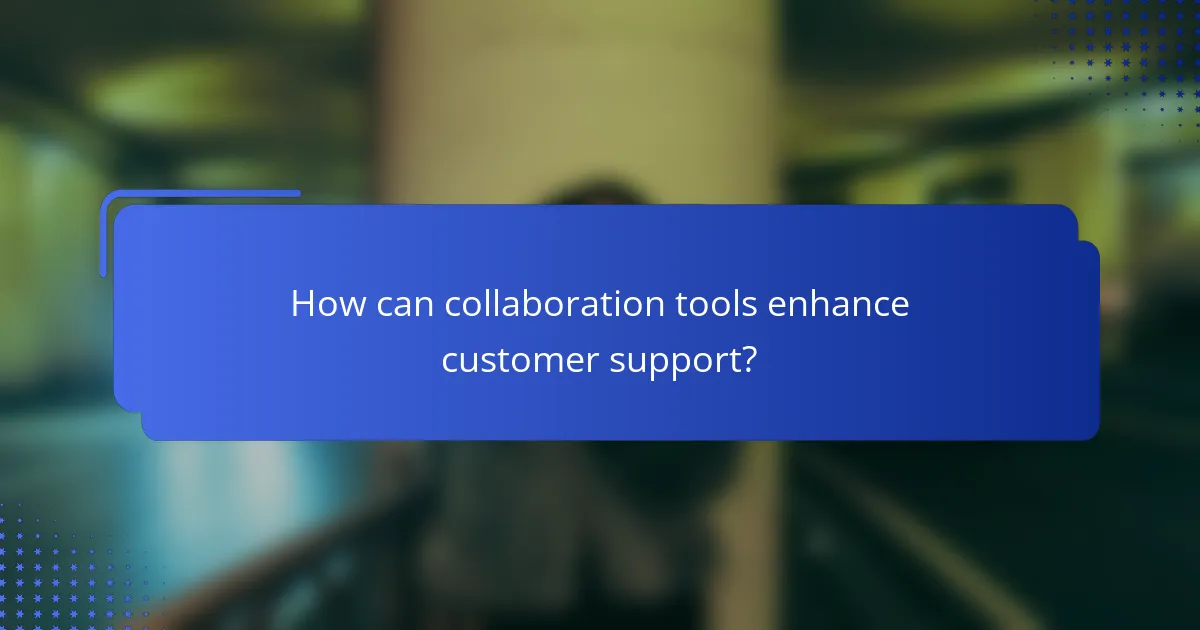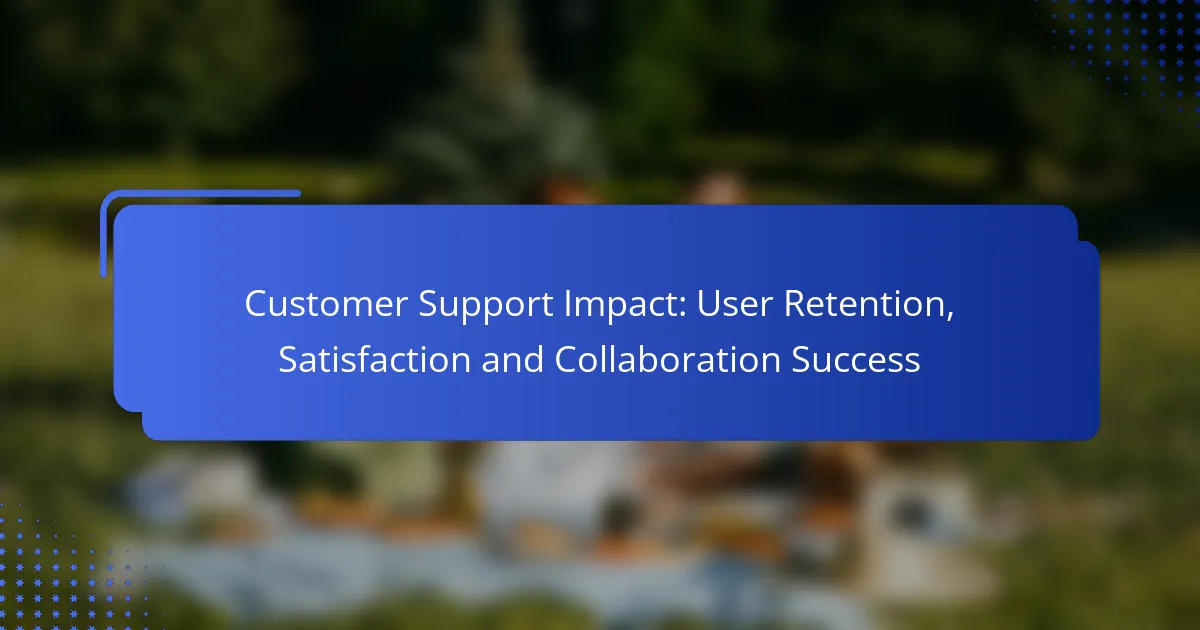Customer support is essential for enhancing user retention and satisfaction, particularly in SaaS companies where it directly impacts customer loyalty and churn rates. By effectively addressing issues and fostering positive experiences, support teams can build long-term relationships with users. Additionally, collaboration tools play a vital role in streamlining communication and improving response times, further contributing to overall customer satisfaction and retention.

How does customer support impact user retention in SaaS?
Customer support plays a crucial role in user retention for SaaS companies by directly influencing user satisfaction and loyalty. Effective support can reduce churn rates and foster long-term relationships with customers, ultimately leading to increased revenue and growth.
Improved response times
Quick response times are essential for retaining users in a competitive SaaS market. Customers expect timely assistance, often within minutes or a few hours, depending on the complexity of their issues. Meeting these expectations can significantly enhance user satisfaction and decrease the likelihood of users seeking alternatives.
To improve response times, companies should implement tools like chatbots for immediate queries and prioritize ticketing systems that categorize issues by urgency. Regularly monitoring response metrics can help identify areas for improvement.
Personalized interactions
Personalized interactions can greatly enhance the customer experience and contribute to user retention. When support teams tailor their communication based on user history and preferences, customers feel valued and understood, which fosters loyalty.
Utilizing customer relationship management (CRM) systems can facilitate personalized interactions by providing support agents with relevant user data. Training staff to recognize and respond to individual customer needs is also vital for creating meaningful connections.
Proactive engagement strategies
Proactive engagement strategies can prevent issues before they arise, leading to higher user retention rates. By reaching out to customers with helpful resources, updates, or check-ins, companies can demonstrate their commitment to customer success.
Examples of proactive strategies include sending educational content, offering regular product updates, or conducting satisfaction surveys. These efforts not only enhance user experience but also build trust and encourage long-term loyalty.

What role does customer support play in user satisfaction?
Customer support is crucial for enhancing user satisfaction by addressing issues, providing assistance, and fostering positive experiences. Effective support can lead to higher retention rates and stronger customer loyalty.
Quality of support interactions
The quality of support interactions significantly impacts user satisfaction. When customers receive knowledgeable, empathetic, and timely assistance, they are more likely to feel valued and understood. This can lead to improved perceptions of the brand and increased likelihood of repeat business.
To ensure high-quality interactions, companies should train support staff in both technical skills and soft skills. Regularly reviewing and updating training materials can help maintain high standards.
Availability of support channels
Having multiple support channels available is essential for meeting diverse customer preferences. Options such as phone, email, live chat, and social media allow users to choose the method that suits them best, enhancing their overall experience.
Businesses should aim to provide support across various platforms and ensure that these channels are easily accessible. For instance, offering 24/7 support through live chat can significantly improve user satisfaction, especially in global markets.
Feedback collection and implementation
Collecting and implementing customer feedback is vital for continuous improvement in support services. Regular surveys, feedback forms, and direct communication can help identify areas for enhancement and gauge user satisfaction levels.
Companies should actively analyze feedback and make necessary adjustments to their support processes. For example, if users consistently report long wait times, it may be beneficial to increase staffing during peak hours or enhance self-service options to alleviate pressure on support teams.

How can collaboration tools enhance customer support?
Collaboration tools significantly enhance customer support by streamlining communication, improving response times, and fostering teamwork among support agents. These tools facilitate better information sharing and coordination, ultimately leading to higher customer satisfaction and retention.
Integration with CRM systems
Integrating collaboration tools with Customer Relationship Management (CRM) systems allows support teams to access customer data seamlessly. This integration helps agents view customer history, preferences, and previous interactions, enabling personalized support.
When selecting a collaboration tool, ensure it offers robust CRM integration options. Popular CRMs like Salesforce and HubSpot often have built-in integrations or compatible APIs that can enhance support workflows.
Real-time communication features
Real-time communication features, such as chat and instant messaging, allow support teams to respond to customer inquiries quickly. These features reduce response times to mere seconds, which is crucial for maintaining customer satisfaction.
Consider using tools that offer video conferencing and screen sharing, as these can help resolve complex issues more effectively. Ensure that your team is trained to use these features efficiently to maximize their impact on customer support.
Shared knowledge bases
Shared knowledge bases provide a centralized repository of information that support agents can access to resolve customer issues. By having a well-organized knowledge base, teams can reduce the time spent searching for solutions and improve the consistency of responses.
Regularly update the knowledge base with new information and best practices. Encourage team members to contribute by sharing insights from their interactions with customers, which can help keep the content relevant and useful.

What are the best practices for customer support in the UK?
Effective customer support in the UK hinges on understanding local needs, adhering to regulations, and fostering strong communication. Implementing best practices can significantly enhance user retention and satisfaction.
Adapting to local customer preferences
Understanding local customer preferences is crucial for delivering effective support. UK customers often value prompt responses and personalized service, which can be achieved through tailored communication strategies.
Utilizing local dialects and cultural references in customer interactions can enhance relatability. For example, using British English terms and addressing customers by their preferred names can create a more engaging experience.
Compliance with UK regulations
Compliance with UK regulations, such as the General Data Protection Regulation (GDPR), is essential for customer support operations. Ensuring that customer data is handled securely and transparently builds trust and loyalty.
Support teams should be trained on data protection principles and the rights of customers regarding their personal information. Regular audits and updates to privacy policies can help maintain compliance and avoid potential penalties.

How do customer support metrics influence business decisions?
Customer support metrics play a crucial role in shaping business decisions by providing insights into user satisfaction, retention, and operational efficiency. By analyzing these metrics, companies can identify areas for improvement, allocate resources effectively, and enhance overall customer experience.
Tracking customer satisfaction scores
Customer satisfaction scores (CSAT) are essential for understanding how well a business meets customer expectations. Regularly measuring CSAT through surveys can help businesses pinpoint strengths and weaknesses in their support services.
To effectively track CSAT, consider using a simple rating scale, such as 1 to 5, where customers can easily express their satisfaction. Aim for a target score in the high 80s to low 90s percentage-wise, as this typically indicates a strong customer experience.
Common pitfalls include relying solely on one-time surveys or neglecting to follow up on feedback. Instead, implement ongoing feedback mechanisms and act on the insights gathered to foster continuous improvement.
Analyzing support ticket trends
Analyzing support ticket trends provides valuable insights into recurring issues and customer pain points. By categorizing tickets based on type, resolution time, and customer demographics, businesses can identify patterns that inform strategic decisions.
For effective analysis, utilize ticketing software that allows for easy tracking and reporting. Look for trends over time, such as spikes in ticket volume during specific periods or common issues that arise, which can guide product improvements or training needs.
Be cautious of misinterpreting data; ensure you consider external factors that may influence ticket trends, such as product launches or seasonal changes. Regularly review and adjust your support strategies based on these analyses to enhance customer satisfaction and retention.

What emerging trends are shaping customer support in SaaS?
Emerging trends in customer support for SaaS are increasingly focused on automation, personalization, and integration with other business tools. These trends aim to enhance user retention, boost satisfaction, and improve collaboration success by providing faster and more tailored support experiences.
Increased Use of AI and Automation
The integration of AI and automation in customer support is transforming how SaaS companies interact with users. Chatbots and automated response systems can handle routine inquiries, allowing human agents to focus on more complex issues. This not only speeds up response times but also improves overall efficiency.
For example, many SaaS platforms now utilize AI-driven chatbots that can provide instant answers to frequently asked questions. This can reduce the average handling time to just a few seconds, significantly enhancing user satisfaction.
Personalization of Customer Interactions
Personalization is becoming a key trend in customer support, where interactions are tailored based on user behavior and preferences. By leveraging data analytics, SaaS companies can provide customized solutions and recommendations, leading to a more engaging user experience.
For instance, a SaaS tool might analyze a user’s past interactions to suggest relevant features or resources during support chats. This approach not only helps in resolving issues faster but also fosters a sense of loyalty among users.
Integration with Collaboration Tools
Integrating customer support with collaboration tools is essential for improving team communication and problem resolution. SaaS companies are increasingly linking their support systems with platforms like Slack or Microsoft Teams, allowing users to report issues and receive updates directly within their preferred work environment.
This integration streamlines the support process, enabling quicker responses and fostering collaboration among team members. Users can easily escalate issues or share feedback without switching between multiple applications, enhancing overall productivity.
